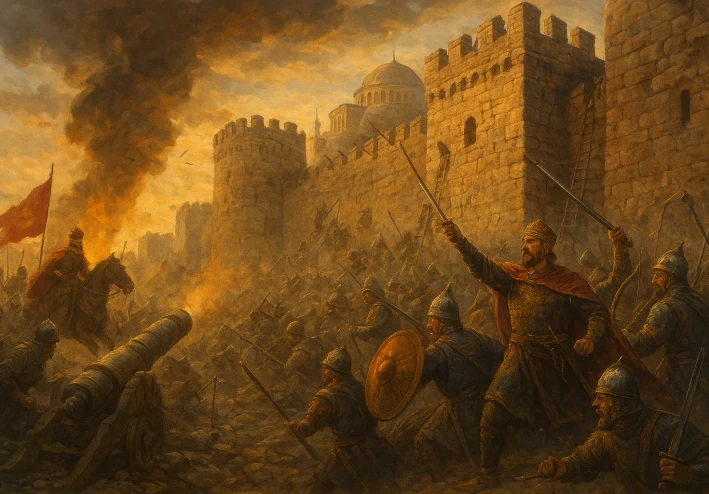The Fall of Constantinople

In the year 1453, the Byzantine Empire stood as a shadow of its former glory. Once the heart of Eastern Christendom, Constantinople now faced the ultimate test of survival. Surrounded by Ottoman forces under the command of the ambitious young Sultan Mehmed II, the city was about to witness one of history’s most dramatic sieges.
The Byzantines had endured centuries of decline, their empire reduced to little more than Constantinople and a few outlying territories. Emperor Constantine XI Palaiologos ruled with courage, but his resources were meager. The walls of the city, once considered impenetrable, were all that stood between the defenders and certain doom.
The Ottoman Ambition
Mehmed II, only twenty-one years old, envisioned Constantinople as the jewel of his empire. He believed that capturing the city would make the Ottomans the unrivaled power of the region and the true heirs to the Roman legacy. With this vision, he prepared meticulously. His army numbered over 80,000 soldiers, including elite Janissaries, while the Byzantines could muster barely 7,000 defenders.
The Ottomans brought something new to siege warfare: massive cannons capable of shattering the ancient walls. These cannons, forged by the Hungarian engineer Urban, were dragged across difficult terrain to the city. Day and night, the thundering artillery bombarded the Theodosian Walls, shaking the confidence of the defenders.
The Siege Begins
The siege began in April 1453. Despite the overwhelming odds, the Byzantines fought valiantly. Emperor Constantine XI refused to abandon his people, declaring that he would rather die than surrender. He inspired soldiers and civilians alike, leading them personally on the ramparts.
The Ottomans launched several assaults but were repelled each time. The defenders hoped for help from Western Europe, but aid never arrived in time. The city remained isolated, its defenders growing weary and supplies dwindling.
The Final Assault
On May 29, 1453, before dawn, the Ottomans launched their decisive attack. Wave after wave of soldiers stormed the walls. Exhausted Byzantine fighters resisted fiercely, but the relentless pressure began to take its toll. Mehmed’s strategy of continuous assaults finally overwhelmed the defenders.
Emperor Constantine XI is said to have discarded his imperial regalia and charged into the fray, fighting until he fell, his body never recovered. The city that had stood for over a thousand years as a bastion of Christianity and culture was no more.
A New Era
Mehmed II entered the city in triumph but showed restraint. He declared that the churches would not be destroyed and allowed the population to live under Ottoman rule. Hagia Sophia, the magnificent cathedral, was converted into a mosque, marking the beginning of a new chapter in history.
The fall of Constantinople signaled the end of the Byzantine Empire and the rise of the Ottoman Empire as a dominant force. It also marked the close of the Middle Ages and the dawn of the modern era.
The city, now Istanbul, became the heart of a vast empire for centuries to come—a symbol of ambition, resilience, and the tides of history.





































